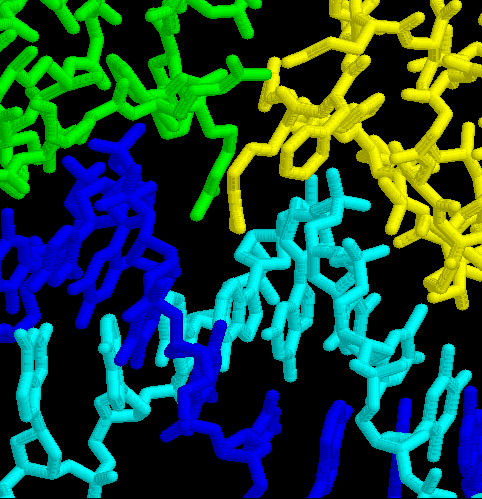
There is no time limit on this test, though I have tried to design
one that you should be able to complete within 3 hours, except
for typing. You are not allowed to use your notes, or any books,
any electronic notes or old tests, nor are you allowed to discuss
the test with anyone until Wednesday Feb. 9, 2000. EXAMS ARE
DUE AT 11:30 ON WEDNESDAY, FEBRUARY 9. You may use a calculator
and/or ruler and you must use the internet for one question but
you are NOT allowed to use any of the computers in the molecular
lab for this question. The answers to the questions must be typed
on a separate sheet of paper unless the question specifically
says to write the answer in the space provided. If you do not
write your answers on the appropriate pages, I may not find them
unless you have indicated where the answers are.
-3 pts if you do not follow this direction.
Please do not write or type your name on any page other than this
cover page. Staple all your pages (INCLUDING THE TEST PAGES)
together when finished with the exam.
Name (please print here):
Write out the full pledge and sign:
Here is the honor code
http://www.davidson.edu/student/redbook/honorgeneral.html#honorcode
"On my honor I have neither given nor received unauthorized information regarding this work, I have followed and will continue to observe all regulations regarding it, and I am unaware of any violation of the Honor Code by others."
How long did this exam take you to complete (excluding typing)?
14 pts.
1. Starting with this peptide (MENAHTKTVEEVLGHFGVNESTGLSLEQ),
answer the following questions. Use the web
page from lab and the internet to answer these questions:
a. From what protein and species is this peptide derived?
b. Find the cDNA online and design two PCR primers to clone the
ORF. Write down the sequences of your primers.
c. What was the vector that contained this clone?
d. From what tissue was this cDNA produced?
10 pts.
2. In the space provided, draw a TTP. You may write just the
letter "T" for the base.
10 pts.
3. List the steps you would need to perform if you wanted
to do a Southern blot of your lab partner to see if she or he
were diploid or haploid. Do not worry about details (e.g. specifically
which enzyme you might use) but make sure you tell me the common
steps in all Southern blots. Also, describe the probe you would
use. You will not know the exact probe, but tell me the general
properties you would want in said probe.
8 pts.
4. Explain how the pET expression system works. You MUST draw
a picture of the pET plasmid and label all its parts to receive
full credit.
8 pts.
5. Design an experiment to determine the molecular weight
of the only human Mg channel that is found in the basement membrane
of toenails. You must determine the molecular weight by an experiment
with real protein; you cannot use only electronic information.
All you know at this point is that mice have the same protein
and that mouse cDNA has been cloned and sequenced.
4 pts.
6. Describe how blue/white selection works when cloning DNA.
12 pts.
7. Read this sequencing gel. Write down the template
sequence from
which this radioactive DNA was derived. Make sure you write your
answer from 5' to 3'.

12 pts.
8. Go to this URL: <bio.davidson.edu/Biology/Courses/Molbio/Exams/2000/exam1fig1.gif>

You will see a picture of two DNA-binding proteins binding to
DNA (DNA is the two shades of blue). Find the two amino acids
binding in the minor groove. Now go to this URL <bio.davidson.edu/Biology/aatable.html>.
a. Explain to me why it makes sense that these amino acids are
both R.
b. Pick a conservative substitution that you think would not disrupt
the quaternary structure depicted. Explain your answer.
c. Choose the most disruptive amino acid substitution you can
imagine and explain your choice.
12 pts.
9. The following requests have been picked up from Mars. It
appears that a life form on Mars has taken the Mars landers hostage
until the following answers can be obtained. (You see, Martians
cannot take molecular biology and they are mean, green, and angry!)
a. Make 350 mL of a solution that is 70 mM KCl, 10% w/v sarkosyl,
and 0.15 M
Tris-HCl (pH 7.8). (FW KCl = 74.5; FW Tris = 121; FW sarkosyl
= 293)
b. Make 125 mL of a 0.45% agarose gel in 0.5X TBE when you are given 10X TBE stock solution. (FW agarose 66; FW TBE = 123)
c. What is the concentration of a stock solution of DNA when the OD260 of some DNA reads 0.025 and this DNA was made by diluting 3 µL of the stock solution into a final volume of 400µL?
d. Tell me how to make 600 mL of a solution that is 0.015M
NaCl, 5% v/v SSC, and
250 mM NaOH. (FW NaCl = 58.44; FW NaOH = 40; you have a stock
solution of SSC).
10 pts.
10. Figure out how to subclone the shaded piece of DNA into
a new copy of the same plasmid. Remember to include an experiment
to verify that you have cloned the correct piece. In the diagram,
K, S, R, X, P, N all represent different restriction sites. The
sizes of the fragments are given in kb. Notice that this big fragment
has been cloned into a polylinker where the different restriction
sites are very close to one another.